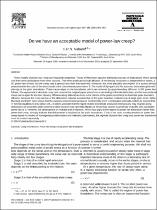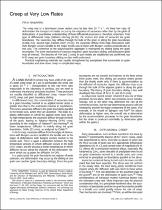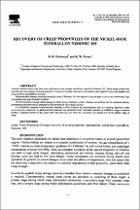JavaScript is disabled for your browser. Some features of this site may not work without it.
- ResearchSpace
- →
- Research Publications/Outputs
- →
- Journal Articles
- →
- View Item
| dc.contributor.author |
Nabarro, FRN

|
|
| dc.date.accessioned | 2007-06-29T06:14:58Z | |
| dc.date.available | 2007-06-29T06:14:58Z | |
| dc.date.issued | 2004-12-15 | |
| dc.identifier.citation | Nabarro, FRN. 2004. Do we have an acceptable model of power-law creep? Materials Science and Engineering A-Structural Materials Properties Microstructure and Processing, vol. 387-389, pp 659-664 | en |
| dc.identifier.issn | 0921-5093 | |
| dc.identifier.uri | http://hdl.handle.net/10204/727 | |
| dc.description | Copyright: 2004 Elsevier Science SA | en |
| dc.description.abstract | Three models of power-law creep are frequently presented. Those of Weertman assume distributed sources of dislocations which spread until they meet dislocations from other sources. They then annihilate by bulk diffusion. If the density of sources is independent of stress, a 9/2 power law follows, but the creep rate is grossly less than that observed. Moreover, the more plausible assumption of a source density proportional to the cube of the stress leads to the conventional power law of 3. The model of Spingarn and Nix assumes dislocation glide with pile-ups at the grain boundaries. These cause steps on the boundaries, which are removed by grain-boundary diffusion. A fifth power law follows. The agreement in absolute creep rate shown in the original paper arises from a misreading of the tabulated data, and the true predicted creep rate is again far too low. Vacancy diffusion along dislocation cores in the interior of the grains is not likely to dominate grain-boundary diffusion, because the cross section of the dislocation network exceeds that of the grain boundary material only at large grain sizes. While Mecking and Estrin have shown that the vacancy concentration produced mechanically even in dislocation cell walls is likely to exceed that in thermal equilibrium only below 1/2 T-m, it seems possible that the highly mobile interstitials produced mechanically may migrate along dislocations of secondary glide systems to allow vacancy and interstitial dipoles of the primary system to annihilate mutually, with a probable power law of 5. However, the observations of Andrade and Hanson, which may apply to the regime of power-law breakdown rather than power-law creep strongly, indicate that deformation is localized at the grain boundaries. If this is the case, existing theories of power-law creep based on models of homogeneous deformation are irrelevant; alternatively, the regimes of power-law creep and power-law breakdown must be treated separately. | en |
| dc.language.iso | en | en |
| dc.publisher | Elsevier Science SA | en |
| dc.subject | Creep mechanisms | en |
| dc.subject | Power-law creep | en |
| dc.subject | Creep power-law breakdown | en |
| dc.subject | Creep models | en |
| dc.subject | Materials sciences | en |
| dc.title | Do we have an acceptable model of power-law creep? | en |
| dc.type | Article | en |
| dc.identifier.apacitation | Nabarro, F. (2004). Do we have an acceptable model of power-law creep?. http://hdl.handle.net/10204/727 | en_ZA |
| dc.identifier.chicagocitation | Nabarro, FRN "Do we have an acceptable model of power-law creep?." (2004) http://hdl.handle.net/10204/727 | en_ZA |
| dc.identifier.vancouvercitation | Nabarro F. Do we have an acceptable model of power-law creep?. 2004; http://hdl.handle.net/10204/727. | en_ZA |
| dc.identifier.ris | TY - Article AU - Nabarro, FRN AB - Three models of power-law creep are frequently presented. Those of Weertman assume distributed sources of dislocations which spread until they meet dislocations from other sources. They then annihilate by bulk diffusion. If the density of sources is independent of stress, a 9/2 power law follows, but the creep rate is grossly less than that observed. Moreover, the more plausible assumption of a source density proportional to the cube of the stress leads to the conventional power law of 3. The model of Spingarn and Nix assumes dislocation glide with pile-ups at the grain boundaries. These cause steps on the boundaries, which are removed by grain-boundary diffusion. A fifth power law follows. The agreement in absolute creep rate shown in the original paper arises from a misreading of the tabulated data, and the true predicted creep rate is again far too low. Vacancy diffusion along dislocation cores in the interior of the grains is not likely to dominate grain-boundary diffusion, because the cross section of the dislocation network exceeds that of the grain boundary material only at large grain sizes. While Mecking and Estrin have shown that the vacancy concentration produced mechanically even in dislocation cell walls is likely to exceed that in thermal equilibrium only below 1/2 T-m, it seems possible that the highly mobile interstitials produced mechanically may migrate along dislocations of secondary glide systems to allow vacancy and interstitial dipoles of the primary system to annihilate mutually, with a probable power law of 5. However, the observations of Andrade and Hanson, which may apply to the regime of power-law breakdown rather than power-law creep strongly, indicate that deformation is localized at the grain boundaries. If this is the case, existing theories of power-law creep based on models of homogeneous deformation are irrelevant; alternatively, the regimes of power-law creep and power-law breakdown must be treated separately. DA - 2004-12-15 DB - ResearchSpace DP - CSIR KW - Creep mechanisms KW - Power-law creep KW - Creep power-law breakdown KW - Creep models KW - Materials sciences LK - https://researchspace.csir.co.za PY - 2004 SM - 0921-5093 T1 - Do we have an acceptable model of power-law creep? TI - Do we have an acceptable model of power-law creep? UR - http://hdl.handle.net/10204/727 ER - | en_ZA |









